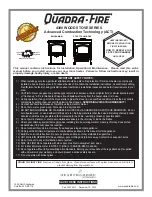
9
Defiant
®
1975 Non-Catalytic / Catalytic Woodburning Stove
30005220
ST245
fireplace
flex connector
12/99
Flexible
Connector
Mantel Shield
Fireplace Adapter Kit
“Positive Connection”
ST245
Fig. 9
Through the fireplace installation.
DEFIA
N
ST493
Brick pass thru
11/00
Wall Stud
Chimney
Connector
Floor Protec-
tion
12” of
Noncombustible
Material
ST493
Fig. 10
An approved wall pass-through for the United States.
must be possible to re-open the damper to inspect
or clean the chimney.
Through the Fireplace
If your fireplace opening height is at least 29" (737 mm),
you may install a Defiant through the opening using a
“positive connection” kit, available from your local deal-
er. Positive connection kits ensure a tight fit between
the stove flue collar and the chimney flue. (Fig. 9)
Fireplace installations, whether connected to the flue
above or through the fireplace opening, have special
clearance requirements to adjacent trim and the mantel.
You’ll find the required safe clearances for Defiant fire-
place installations on Page 13.
Floor protection requirements also apply to fireplace
installations. This information is on Page 11.
wall pass-Throughs
Whenever possible, design your installation so the con-
nector does not pass through a combustible wall. If you
are considering a wall pass-through in your installation,
check with your building inspector before you begin.
Also, check with the chimney connector manufacturer
for any specific requirements.
Accessories are available for use as wall pass-
throughs. If using one of these, make sure it has been
tested and listed for use as a wall pass-through.
In the United States, the National Fire Protection As-
sociation (NFPA) has established guidelines for passing
chimney connectors through combustible walls. Many
building code inspectors follow these guidelines when
approving installations.
Figure 10 shows one NFPA-recommended method. All
combustible material in the wall is cut away from the
single-wall connector to provide the required 12” (305
mm) clearance. Any material used to close up the open-
ing must be noncombustible.
Three other methods are also approved by the NFPA:
•
Placing a section of chimney connector inside a
ventilated thimble, which in turn is separated from
combustibles by 6” (152 mm) of fiberglass insulat-
ing material.
•
Placing a section of chimney connector inside a
section of 9” (230 mm) diameter, solid-insulated,
factory-built chimney, with 2” (51 mm) of air space
between the chimney section and combustibles.
•
Using a section of solid-insulated double-wall high
temperature chimney, with an inside diameter the
same as the chimney connector, at least one inch
of solid insulation, and a minimum of 9” (229 mm)
air space between the outer wall of the chimney
section and combustibles.
In Canada, The Canadian Standards Association has
established different guidelines for wall pass-throughs.
Figure 11 shows one method, in which all combustible
material in the wall is cut away to provide the required
18” (457 mm) clearance for the connector. The resulting
space must remain empty. A flush-mounted sheet metal
cover may be used on one side only. If covers must be
used on both sides, each cover must be mounted on
noncombustible spacers at least 1” (25 mm) clear of the
wall.










































